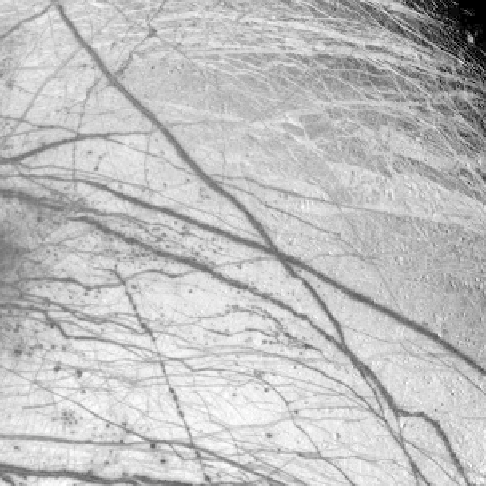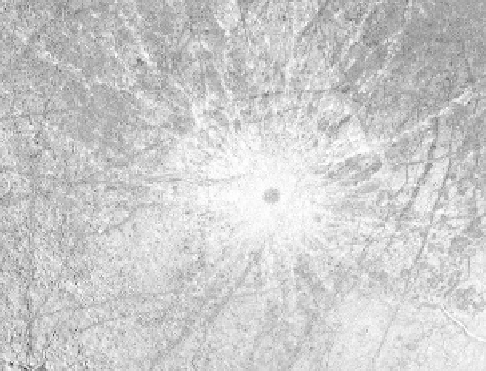Geology Reference
In-Depth Information
Figure 8.17. Pwyll crater is the youngest large (26 km in diameter)
impact on Europa; the bright rays of length > 1,000 km consist of
water-ice grains (NASA Galileo PIA01211).
8.5.2 Tectonic features
Figure 8.16. This Galileo image of the northern hemisphere of
Europa is 1,260 km across. The light-toned plains are oldest, while
the dark linear fractures cut across the plains and are the youngest
features in this area (NASA PIA00275).
Europa
'
s tectonic features include ridges, bands, and frac-
tures. Ridges are common and appear to have formed
throughout the visible history of Europa. They range
from 0.1 to > 500 km long, are as wide as 2 km, and can
be several hundred meters high. Ridges include simple
structures, double ridges separated by a trough
(Fig. 8.19)
,
and intertwining ridge-complexes. Whether the variations
represent different processes or different stages of the
same process is unknown. Cycloidal ridges are similar to
double ridges but form chains of linked arcs
(Fig. 8.20)
.
Most models for the formation of ridges include fracturing
in response to processes within the ice shell, most of which
are related to tidal stresses. Some models (Prockter and
Patterson,
2009
) suggest that ridges form by frictional heat-
ing and possible melting along fracture shear zones. Other
models suggest that oceanic material or warm mobile
subsurface ice squeezes through fractures to form the
ridge. In this case, ridges might represent
were not so clear because the amount of heat predicted
from tidal stresses was right on the border for the amount
needed to generate magma or to keep the base of the ice
crust liquid.
Only about 24 impact craters
≥
10 km were identi
ed in
Galileo images, re
ecting Europa
'
s very young surface,
estimated to be aged 40
90Myr (
Fig. 4.50)
. This is
remarkable in comparison with Earth
-
is Moon, which is
only slightly larger but far more heavily cratered. The
youngest known Europan crater is Pwyll, 24 km in diam-
eter, which displays abundant secondary craters and
retains its bright rays. Pwyll probably formed less than 5
Myr ago
(Fig. 8.17)
.
Crater morphology provides insight into ice thickness
at the time of impact. Morphologies vary from small
bowl-shaped depressions with crisp rims formed entirely
in ice, to shallow depressions with smaller depth-to-
diameter ratios. Craters up to 25
'
”
between the surface ice and the deeper ocean. Such
exchanges could provide a means for surface oxidants to
enter the ocean, which would make the formation of habit-
able zones more likely.
Bands re
ect fracturing and separation of slabs of the ice
crust
(Fig. 8.21)
,muchlikesea-
oor spreading on Earth,
and most display bilateral symmetry. The youngest bands
tend to be dark, while older bands are bright, suggesting
brightening with time. Geometric reconstruction of bands
suggests that a spreading model is appropriate, indicating
extension in these areas.
“
communication
30 km in diameter have
morphologies consistent with formation in a warm but
solid icy shell, while the two largest impacts (Tyre and
Callanish,
Fig. 8.18)
might have punched through brittle
ice about 20 km deep into a liquid zone.
It should be noted that, regardless of the overall thick-
ness of the icy crust, there could be isolated pockets of salt
water (brine) within the ice shell at shallow depths.
-




